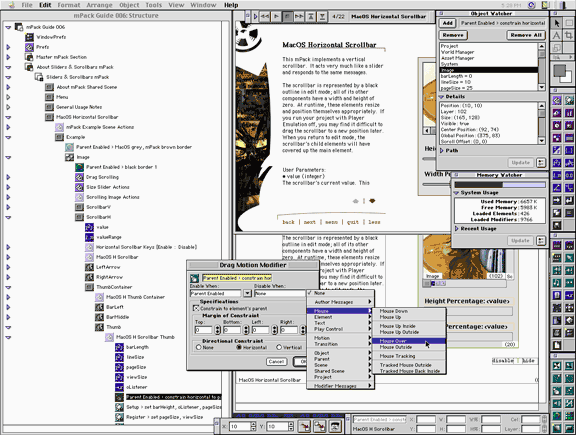At mFactory I worked on the design of mTropolis, an object-oriented multimedia authoring tool. mTropolis was designed to empower non-programmers to create complex multimedia applications, using a drag-and-drop, icon-based environment.
The left-most window here displays the hierarchical structure of the user’s project, from the root project level down through sections, subsections, scenes and then to individual elements and modifiers. The structure view works much like the MacOS Finder.
Modifiers (the colored icons) can be dropped onto elements (images, movies, sounds, etc.) to provide encapsulated bits of behavior. For example, the screenshot here shows the Drag Motion Modifier dialog. This modifier turns the element that contains it into a draggable object.
The popup menu is being used to select a message that will disable the modifier when it receives it. By configuring modifiers to send and receive messages, the user can set up very complex interactions and behaviors.
As an interface designer I collaborated closely with engineering, documentation, and marketing teams while designing new mTropolis functionality. Another important source of design feedback was our user base. By working with our in-house production team, conducting customer site visits, communicating with our alpha and beta users as well as responding to the mTropolis mailing list, I was able to incorporate our users’ goals and needs into the entire development process.
When Quark, Inc. purchased mFactory in 1997, I stayed on to finish version 2.0, despite an attitude held by the new owners that might generously be called “benign neglect” (if laying off half the company is benign). When mTropolis 2.0 shipped in March 1998, Quark laid off the remaining diehards and killed the product. Such is life in the Valley.
Still, mTropolis lives on. Three years later, a cadre of die-hard users continues to build multimedia presentations with the now unsupported tool. They trade tips and tricks through an online forum.
